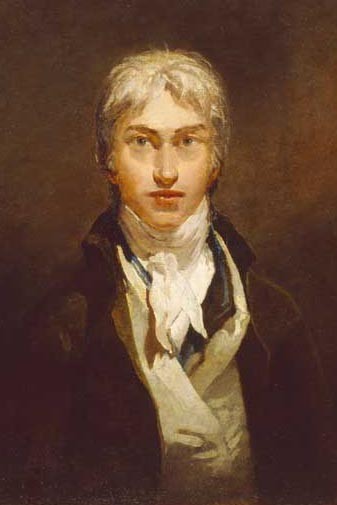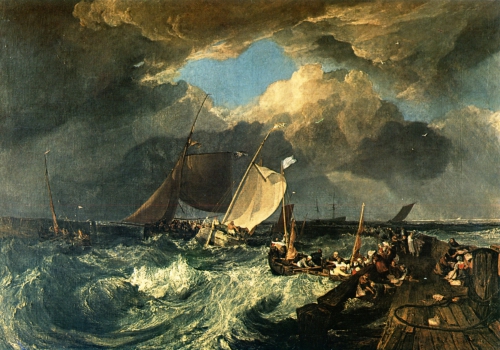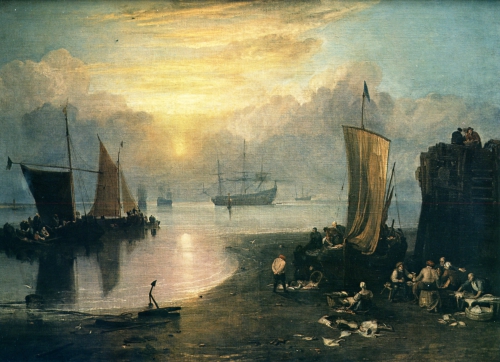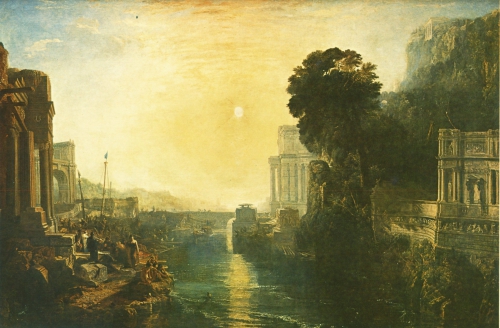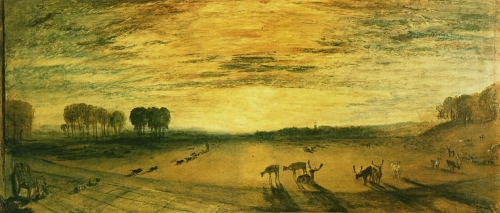Joseph Mallord William Turner | XIXe | Joseph Mallord William Turner
Joseph Mallord William Turner (English Joseph Mallord William Turner, April 23, 1775 - December 19, 1851) - British painter, master of romantic landscape, forerunner of the French impressionists.
William Turner was born in late April - early May 1775 in London's Covent Garden district. Turner himself called the date of his birth April 23, which, however, is disputed by a number of researchers. The artist's father, William Turner, was a wig maker, and in the late 70s. opened a barber shop. In 1785, due to the difficult situation in the family (his mother was mentally ill), Joseph William was sent to the London suburb of Brentford, where he lived with his uncle.
While still in Brentford, he developed an interest in the visual arts. After attending school in the late 1780s, he settled in London, where he worked for architects and surveyors, including Thomas Malton. In December 1789, 14-year-old Turner was admitted to the Royal Academy and was examined by Reynolds. At the academy, he attended the last lectures of Reynolds, who had a significant influence on Turner. Subsequently, the artist carefully studied the entire course of lectures by the first president of the academy, dedicated to the idealistic direction in art. A year after his admission, Turner’s watercolor work was exhibited at the annual exhibition of the Academy of Arts. The first oil painting to be exhibited came from Turner in 1790. Subsequently, Turner constantly exhibited at the Academy. From 1791 he worked as a stage designer at the Pantheon Opera on Oxford Street and earned extra money by giving lessons.
Turner carefully studied the masters of the past and contemporary artists. Copying other people's works, he creatively reinterpreted other people's images, expressing his own vision. He was especially admired by Claude Lorrain: according to a contemporary, after seeing the painting “The Departure of the Queen of Sheba,” Turner could not help but cry. The artist explained his reaction by saying that he would never create something like that. Years later, Turner bequeathed his Dido, Founder of Carthage, which he considered an unsurpassed masterpiece, to the National Gallery with the condition that it hang next to The Departure of the Queen of Sheba. Turner carefully studied Lorrain's paintings available to him, as well as albums with Liber Veritatis engravings. The engravings were made from drawings by a French artist dating back to his mature period of creativity. Turner later released the album Liber Studiorum, made in the same technique as the album of Lorrain's drawings - mezzotint. Liber Studiorum was intended to be used as a textbook for beginning artists and the engravings were grouped into thematic sections - architectural, historical, pastoral (mythological and everyday) painting, sea and mountain landscapes.
Turner made his first sketch trip in 1791. Subsequently, he traveled a lot with a traveling palette and made sketches in Europe (Switzerland, the French Alps, Italy). Turner left behind more than ten thousand drawings and sketches. Materials from the travel albums served the artist as the basis for paintings and watercolors, which he worked on in London, sometimes turning to his very old sketches.
On November 4, 1799, Turner, who had by then become a popular artist, was elected a corresponding member of the Royal Academy. In 1801, he exhibited the sea at Bridgewater at the Academy, which was a resounding success, and the artist Benjamin West even compared Turner to Rembrandt. On February 10, 1802, Turner became the youngest artist to receive the title of Royal Academician. This title gave him the right to exhibit, bypassing the selection committee, which pre-screened all the works.
Turner constantly improved his technique, studied the connection between architecture and geology, the nature of the movement of water and air. By the beginning of the 19th century, in his watercolors he achieved the power and expressiveness usually inherent in oil painting. By discarding excessive detail, he created a new type of landscape through which the artist revealed his memories and experiences. Turner introduced images of people in scenes of walks, picnics, and field work into his paintings. Carefully and lovingly depicting a person, the artist emphasized the imperfection of his nature, his powerlessness in front of the huge world around him, sometimes calm, sometimes menacing, but always indifferent.
In 1807 Turner took up the position of professor of perspective at the Royal Academy. However, the training program he compiled covered a much wider range of issues than the study of perspective. It was a kind of adaptation of Reynolds' lecture course and addressed Turner's favorite topic - issues of "poetic painting".
He gained particular fame thanks to his paintings dedicated to the Napoleonic Wars (“Battle of Trafalgar”, “Field of Waterloo”).
In 1819, Turner visited Italy for the first time. He visited Turin, Milan, Rome, Venice, Naples. He studied the works of Titian, Tintoretto, Raphael, and contemporary Italian artists. After traveling to Italy, his painting became more vibrant, his palette more intense.
noah with a predominance of primary colors. The Venetian theme occupied a special place in the artist’s work. He visited this extraordinary city three times (in 1819, 1833, 1840), and memories of it fueled his imagination for many years.
Already in the 1800s, Turner's successes attracted criticism from the collector and artist Sir George Beaumont, who criticized the "liberties" and bright colors of his paintings. Later, the artist’s innovative work, anticipating the achievements of painting at the end of the 19th and beginning of the 20th centuries, caused an ambiguous assessment in his contemporary society. The Victorian public, who preferred photographic realism, saccharine sentimentalism, and “harmonious” but expressionless color schemes, did not accept many of his paintings well. In the 30s and 40s, critical attacks against Turner appeared more and more often. Some of his works, bordering on abstractionism, gave the artist a reputation as a madman. Queen Victoria refused to knight him. One of the few who came to Turner's defense was John Ruskin, who called him "the greatest artist of all time."
The painter died on December 19, 1851.

